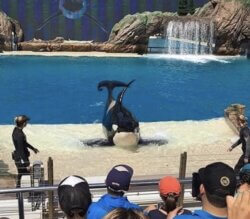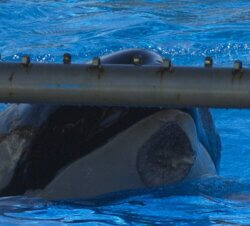The young orca Nakai, who was born at SeaWorld San Diego and lived in a tank there all of his life, has died. He was just a few weeks short of his 21st birthday.
On August 5th, SeaWorld announced that “Every attempt was made to save his life. Veterinarians and health specialists had been actively treating an infection, but aggressive therapeutic and diagnostic efforts were unsuccessful.”

Photo of Nakai from Creative Commons by Zaleem324
Nakai’s mother was Kasatka, who died in 2017. Tilikum, who lived at SeaWorld Orlando, was his father by artificial insemination.
Nakai’s half-sister Kalia was fathered by Keet, who has lived at SeaWorld parks in San Diego, San Antonio and Ohio.
One of his half-brothers, Makani, was fathered through artificial insemination by Kshamenk, who lives in an amusement park in Buenos Aires, Argentina.
His other half-brother, Ikaika, was fathered by Tilikum. Ikaika spent several years at Marineland Canada, as part of deal between SeaWorld and Marineland with the aim of breeding Kiska and alternating ownership of the calves between the two companies. But in 2011, a custody battle erupted. SeaWorld won the case in court and Ikaika ended up back in San Diego.
If this piece of family genealogy seems a bit confusing and convoluted, that’s because it is. It does, however, give the briefest glimpse into the breeding and interbreeding of whales for profit among amusement parks around the world. In one of many other examples, the orca Keto lived at every SeaWorld park in the United States before being transported in 2006 to Loro Parque Zoo in the Canary Islands, where he killed his trainer, Alexis Martinez, on Christmas Eve 2009. He went on to father Ula, the daughter of Morgan, which was a violation of the conditions of her transfer from a dolphinarium in the Netherlands.

Nakai in 2012 after he had sustained an injury to his jaw. Photo By Ingrid Visser.
In 2016, SeaWorld made a pledge to stop the breeding of orcas at its facilities and to begin replacing its circus acts with “new, inspiring orca encounters” and more naturalistic presentations.
The whales, however, continue to live in totally unnatural conditions that subject them to chronic stress, leading to immune system dysfunction and high morbidity and mortality. (Nakai’s death comes less than a year since the demise of six-year-old Amaya, also at SeaWorld San Diego, about whom the company wrote that “her death was sudden and unexpected.”)
The conditions they’re kept in also lead to violence. The same week we learned of the death of Nakai at SeaWorld San Diego, the animal protection group PETA posted video of another of the orcas there being attacked by tankmates. You hear the voices of horrified young children, and an eyewitness writes: “We all immediately saw blood soaking the water, which triggered my nine-year-old daughter to start crying.”
As we post this account, we have not heard anything from SeaWorld about that incident. But it is now way beyond time for the company to follow the lead that was set earlier this year by the Miami Seaquarium in charting a new course for captive whales. On March 23rd, the new owners of the Seaquarium announced a level of public transparency about the health, welfare and care of the orca known as “Lolita.”
In Nova Scotia, the Whale Sanctuary Project is pioneering a gold-standard sanctuary where orcas and beluga whales can be retired. More sanctuaries will be needed for the many whales in captivity at home and abroad. This first one is being created as a model for others to follow.
What’s needed now is the willingness of the marine mammal entertainment industry to end the shows, to adopt a new level of transparency regarding their health, to begin the process of preparing the animals for retirement, and to join our existing donors in providing the funds for the construction of this first-of-a-kind sanctuary and the care of the whales who will live there.
As world-renowned oceanographer Jean-Michel Cousteau has noted:
“The time has come to see whales in captivity as a part of our past, not a tragic part of our future. Let’s end the shows now and retire these intelligent, social, complex animals to seaside sanctuaries.”
What you can do:
- Ask SeaWorld for a transparent accounting of the death of Nakai and of the violence that was witnessed in one of its most recent shows;
- Invite the company to support the Whale Sanctuary Project, to work with us toward completing the sanctuary, and to move ahead in giving captive whales a new and better future.
Public opinion clearly indicates that it is time for a new relationship to these magnificent and emotionally sensitive animals. Together with the generosity of our existing supporters, the support and cooperation of the marine entertainment companies themselves is the next step in bringing it about.